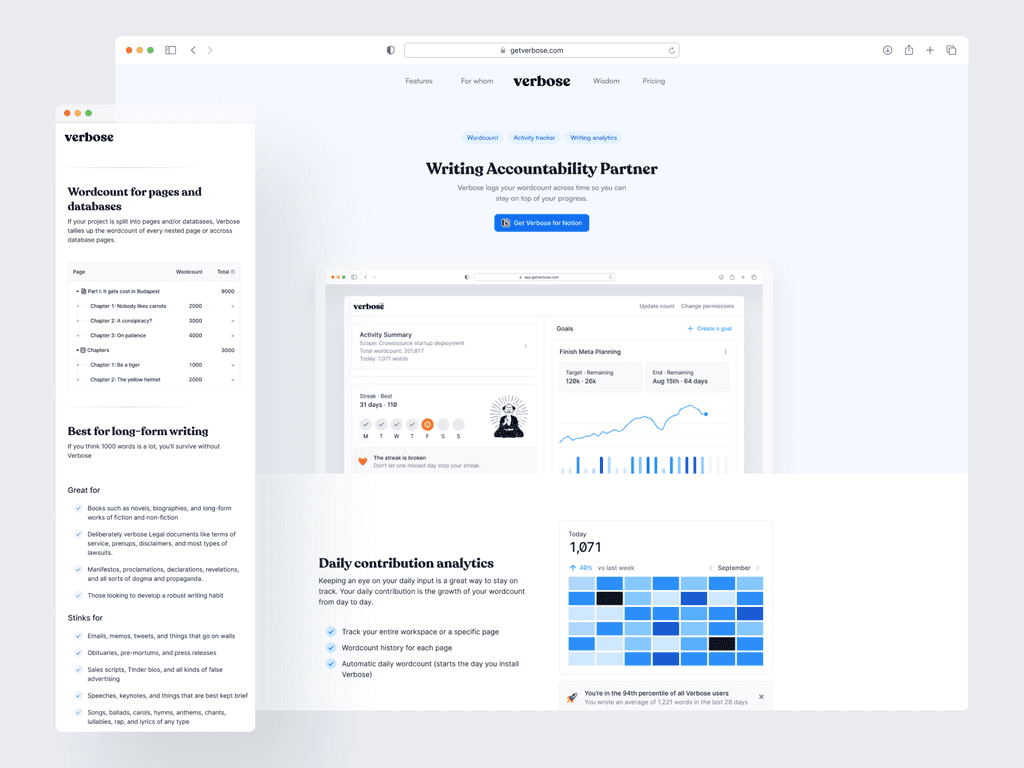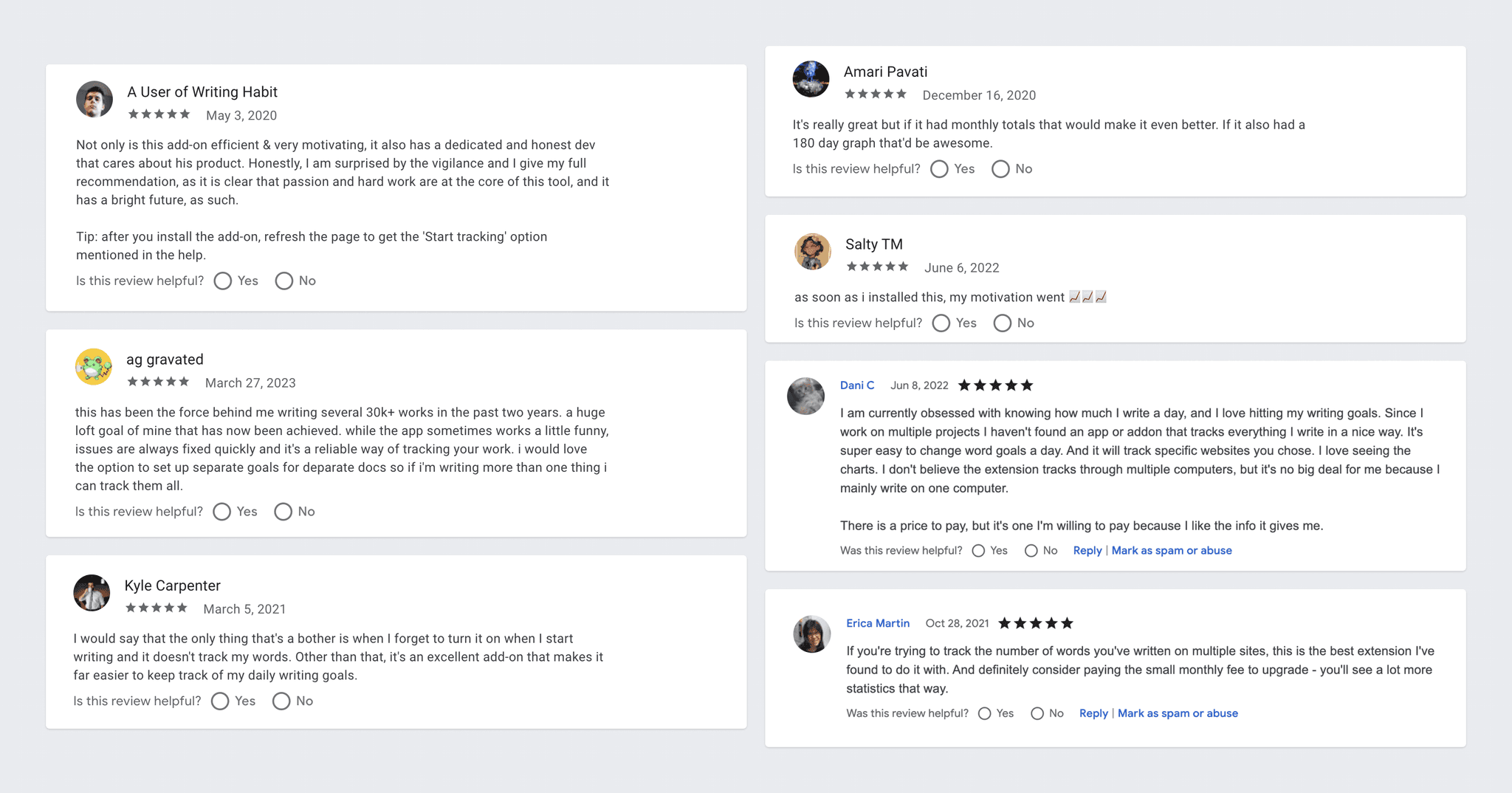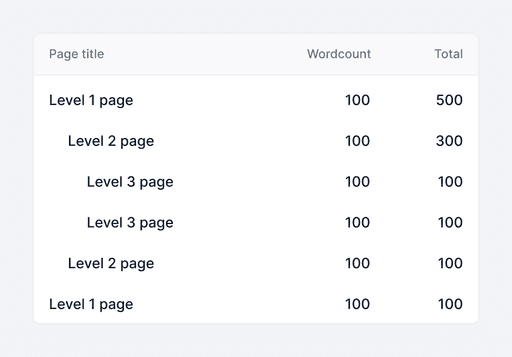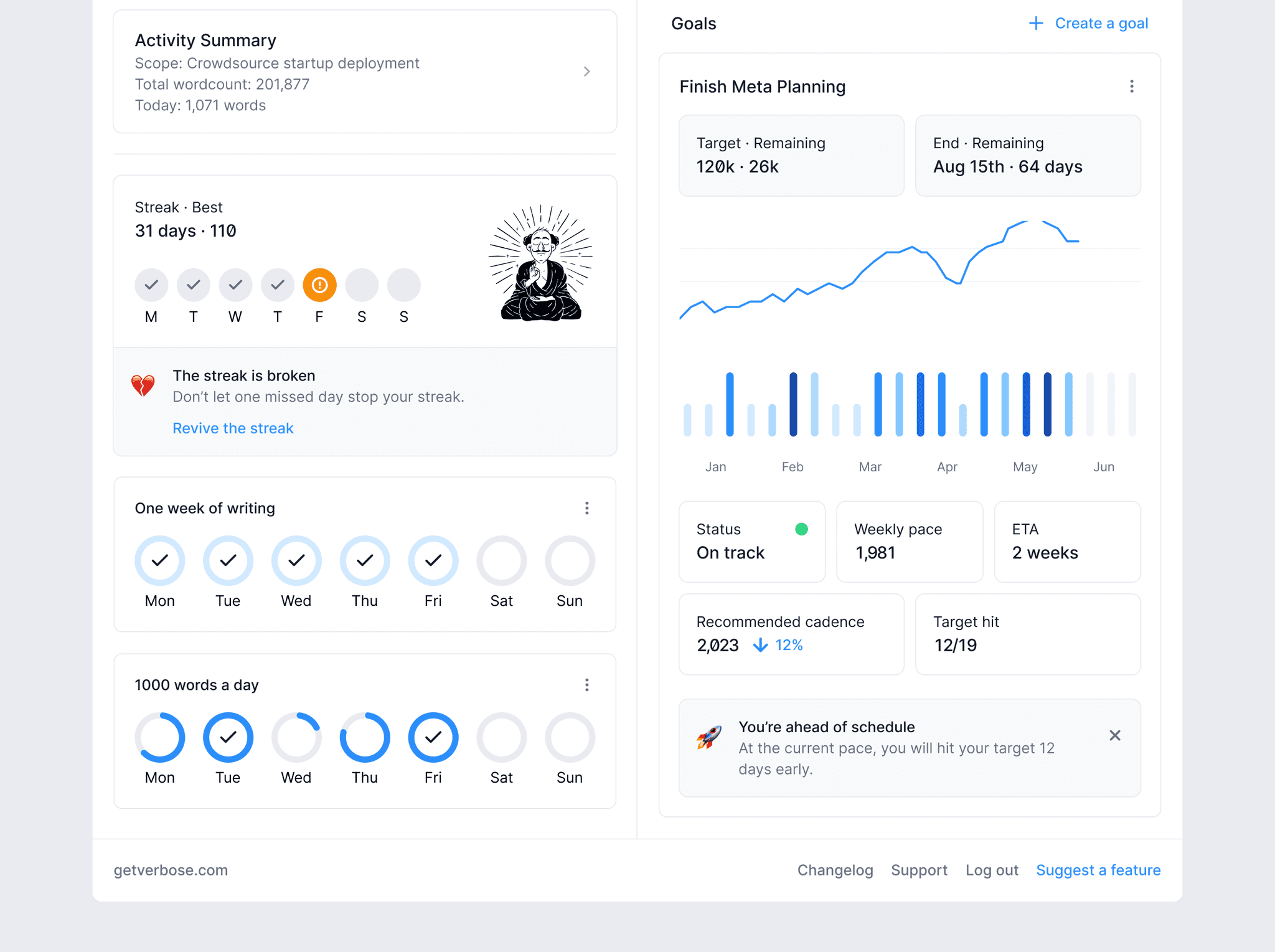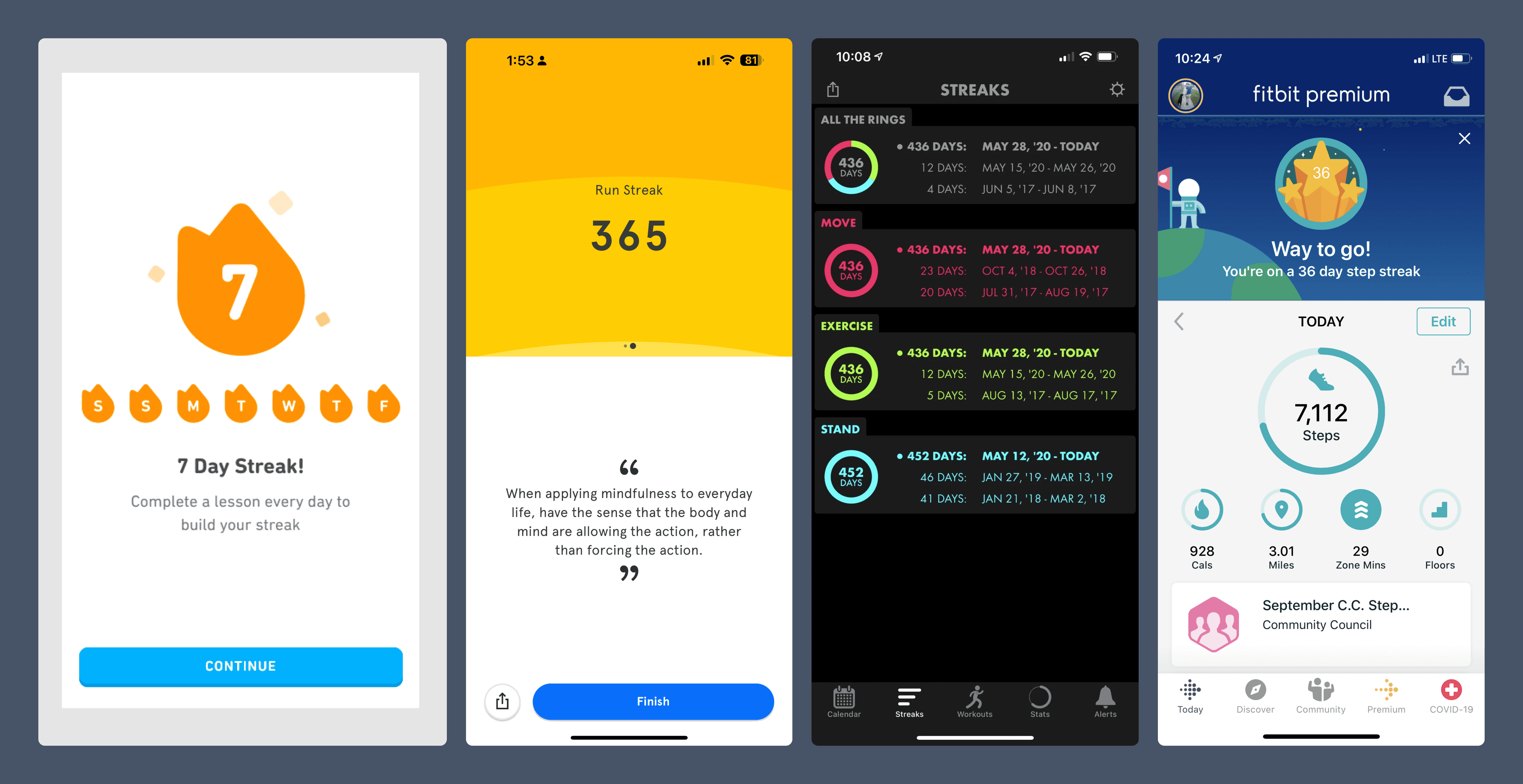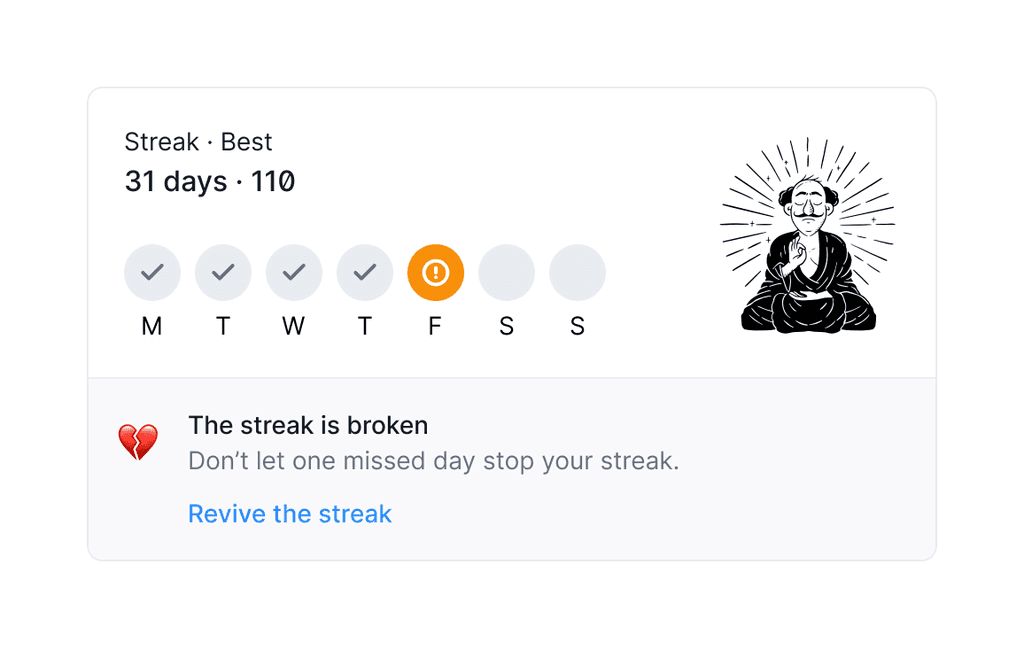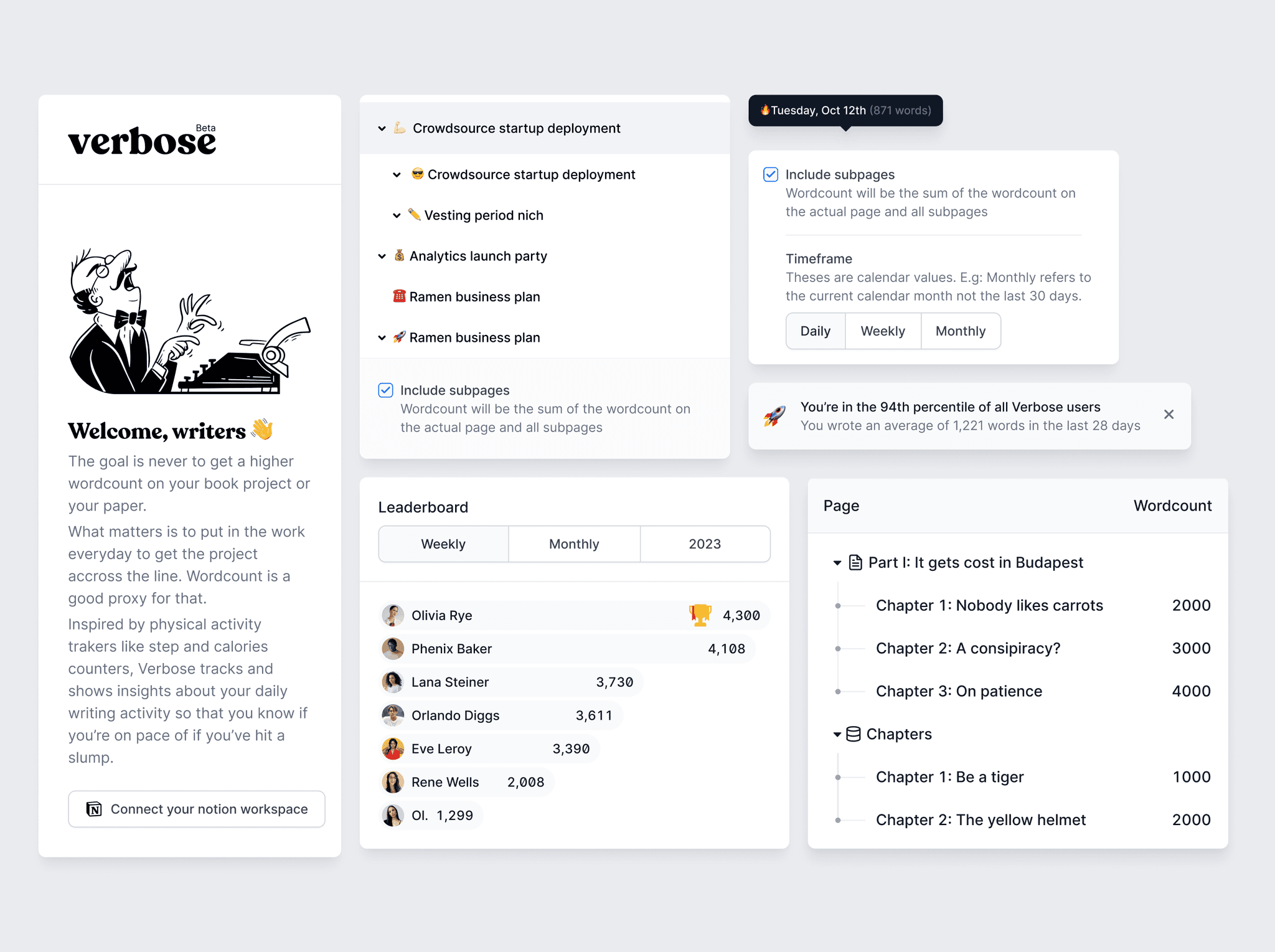Writing accountability partner for Notion writers
Product
UI design
Engineering
Published Dec 2022
·
😤 21 min read
Versbose is a writing accountability partner, for Notion writers. Inspired by physical activity trackers like step and calorie counters, Verbose tracks and shows insights about your daily writing activity. Verbose 2.0 starts from that foundation and builds robust habit forming tools using established gamification patterns.
🚨 Update: I had to pull the breaks on Verbose. I didn't have the engineering resources needed to give it justice, so unfortunately, It's sitting up here on a shelf until I do. If you're an engineer who wants to partner up and help bring Verbose to life, I would love to hear from you
In a nutshell:
This is the first project for The Simple Company (my own company).
Role: Product design, Product management and art direction
Duration: 1 year as a side project (more like 2 months of continuous work)
Output: Currently a Chrome plugin in a private Alpha (Request access)
1. Research
In addition to being a designer, I’m also a writer. I writer everyday. I write thousands and thousands of words every week. I needed something to keep my writing projects on track, so I hired an engineer on Upwork to build me a solution for private use. It was a success. I got attached to the project and invested more to grow it.
Before any of that, I looked for reliable solutions for this problem. None of the solutions worked for me. However, they were a gold mine of free information
You can quickly realize the need for both solutions: Wordcounts and writing habit tracking. There’s no shortage of apps for either. Writing analytics, Writing Habit, Hypergraphia, Write Next are just a few examples of companies trying to solve these problems
There is a lot of demand for such apps. As a writer, I didn’t need to be told this. But this can be easily substantiated in the popularity of Writing analytics which has 25k downloads and 4.1 Star reviews from 124 reviews.
1.1User voices
I have read all the reviews of Writing analytics on the Google workspace store, As well as other app where you can read reviews. Here are a few samples:
There’s also no shortage of Youtube videos on writing. The trick is to find ones that talk about habits and read the comments.
1.2 User profile:
because I’m a writer, these facts were true of me before I got invested in this project. But the research revealed the size of the demand, and validated that I’m not an outlier, not even an extreme case.
Writers care about wordcounts. Call it vanity, call it productivity… They just do.
Writers write a lot, that’s both in terms of frequency and volume. They want to track both.
Motivation is the crux of the problem. Most users aren’t just trying to hit a total wordcount for their project, but somehow, seeing the wordcount motivates them. This is in line with the psychology of motivation . Countless other papers support this and so does personal experience.
While serious writers who have large Novels and screenplays are still using Scrivener, the move is clearly to Notion. This is very explicit in youtube videos, blog posts, and the personal experience of all my friends who write.
1.3 User challenges:
Writers don’t have reliable ways of tracking their writing projects. Existing tools are buggy and very limited. Many tools force users to use a new writing app, which doesn’t seem to be attracting a lot of users.
Building and maintaining a writing habit is tricky because there’s no easily measurable proxy. They can’t use their regular habit tracking apps because it takes too much effort to input both frequency and volume, especially that writers can have multiple sessions per day.
Tracking gets frustrating if a writing project spans across multiple pages. This is where my own problem started and you can see echos
1.4 Business challenges:
There’s a difference between solving a user’s problem, and creating a business that solves a user’s problem. In the latter case, you have two problems to solve. A company that solves this issue has the following challenges:
Given that you’re on the plugin layer, there’s always a threat that the application layer takes away your business. For example, Notion can start supporting this natively.
You don’t want to build your own writing app. There are multiple reasons but the main two is that it’s difficult to even clone a good writing app, and more importantly, it’s hard to get people to switch to a new one Here’s a sample
Monetization isn’t easy. Notion and Google docs themselves are free. Also, say what you want about the competition, but they are free. and Free is good. This is why Verbose is currently a Chrome plugin. That’s the only way you could avoid the running costs of servers. I later discovered that it has to run on the cloud, which is what I’m doing for the Beta. But that means that you’d have to charge money for it. There needs to be a large enough premium version that subsidies the free version. That’s why I started building the habit tracking features in addition to wordcounts.
The Notion API has a very small request volume limit. I’m unsure on how to scale that and you always run the risk of them updating the API and making your life expensive.
2. Wordcounts and writing analytics
2.1 On the challenges of counting words
There’s no dancing around the fact that the holy grail of this problem is a Git-like system. A Git system can take into account editing even in the sense of modifying a word. However, it’s still not perfect.
A Git-like system would require commits which isn’t ideal.
It’s turn based, not real-time: Everything would be calculated on the commit. It would be more accurate, but you don’t get the big happy moment when you reached your goal, which can be Huge for habit building.
The solution that I wish to pursue would involve some form of Git-like system. But there’s a much better, lower hanging fruit.
If we could be live with the user as they’re typing, we can improve all aspects of the experience. Thankfully, this can be done via a browser extension. But what’s even more cool is that we can build a browser bundled with this extension, and it would be used instead of relying solely on the cloud.
From the user’s perspective, if they use the notion app, they can use the Verbose version of Notion, which is functionally identical (it’s the same + the extension running in the background). If they’re one of those psychos who use Notion with their other tabs, then the browser extension got them 😂.
2.1 The challenges of working with hierarchies
Notion does give you a wordcount for every page. What it doesn’t take into account is the wordcount of the pages inside of your page. That was the main premise of Verbose. This is how the solution looks like. A tree structure of pages within pages and their wordcount:
Let’s say your or paper project had 3 top level parts. So those would be your Level 1 pages. Each chapter is comprised of 4 chapters. That’s level 2. each chapter is comprised of a number of sections. That’s level 3. If everyone’s book worked like this, it’s smooth sailing.
The challenge is that books don’t follow the same structure. I know that the most common structure in non-fiction is part-chapter-section, but that’s far from a rule. Consider these examples
So how can you design a feature like: Top growing pages? Wouldn’t these always be the top-level pages
Not just that, but I don’t want to design Verbose only for people who write books. Verbose is for me, and even I write a whole lot of other formats: Articles, journals, case studies like this one, rants, linkedIn posts. I organize each of those differently. So the question is: How can you design a an insightful system that’s agnostic to structure? That’s what scoping is for.
What I mean with scoping is the ability of verbose to limit its output based on specific subsections of the Notion space.
This is not rocket science. You just select which page you want to limit your usage to, and the numbers get updated. What’s interesting about scopes is how I modeled it after Facebook audiences and Mixpanel cohorts and similar analysis tools. So it’s a filter on steroids. It’s a filter that enables a sort of navigation and highlighting at the same time. I learned this trick in airfocus where we had similar challenges with hierarchies.
2.3 Creative direction and Mr. Bose
Verbose is a project for The Simple Company. Therefor, I don’t have to deal with a lot of the limits that come with building projects for real companies. Bullshit like “Don’t insult the customer” and “If a button is there, it needs to do something” 😄. None of that matters. It must work flawlessly for everyone, but it owes nothing more than that to anyone. I want it to charm and enchant. If it does that for a few people, even if on the expense of everyone else, so be it. This is not the way products should be designed. But when you pay for your own project, you get to have fun.
In my heart of hearts, I am cool with spending a year building something that never gets used by anyone other than myself. This product is for me, because I wanted it. It needs to follow the strictest of usability standards because I’m a person and those rules apply to me too. But when it comes to its personality, it will dance to my lead.
I invented the Mr. Bose character to express this personality of the product. There are three guidelines:
Verbose is for writers. Writers like writing. So the personality should be expressed mostly in text, not imagery. Mr. Bose isn’t the brand.
Verbose is a nice to have. It doesn’t solve a big problem. Therefor, it shouldn’t take itself too seriously.
It’s an indie project. So what it lacks in features, it must compensate for with charm.
So I landed on the idea of creating Mr. Bose. You know, verBose. That’s where it came from. he’s heavily inspired by this dribbble shot. I just thought that the look of this guy fits the image that I had in mind. I still laugh about Mr. Bose’s antics every time I see him. In fact, I liked him so much that he’s my mascot, not just for this project.
Mr. Bose is very verbose 😂. He’s full of himself. He’s loud and assertive. But he’s not cool. He’s a sweaty try hard. He’s raw and genuine. He’s bald and old, so he’s relatable and noon-threatening. He looks like he minds his own business. And most of all, strangely, he looks like he could be a writer. I think Mr. Bose is my alter ego.
3. Verbose 2.0: Habit tracking
Verbose 1 is not out yet. I hope it’s going to be live soon. I will start to promote it, get some users, see what works and what doesn’t. My goal is to get an early cohort of people who can give feedback. There’s a big difference between reading comments online and interacting with people in real life.
That being said, I have already established in my initial research that habit tracking cannot be separated from wordcounts. So I have built this concept to support that idea. As I’m getting feedback for Verbose, I will be showing Verbose 2.0 and seeing the reaction, before Even starting to build it.
3.1 few words about the goal tracking
One challenge with goal tracking, and really everything that has to do with tracking writing activity is editing. The problem with editing is that if you have a total wordcount for your goal project, you can be 30k words over, but in reality, you’re 60k under once you finish editing.
The way to solve this problem, and a lot of other product problems is to behave like people behave when they have software limitations. They make the best use of the tools that exist. In this case, the user knows that they will have to edit down their manuscript. They also have a very good sense of how much editing they usually do. “I wrote 3 times as much as I published” “By the time I had finished editing, I was left with half”, “I figured out that there are many parts that needed more work so I had to write additional chapters”. The are the heuristics of writers. Mine is “by the time I finish editing, my work is 30% lighter”. Mind you, this doesn’t mean that I cut 30% off, it means that I might add 20%, remove 50% and then add then add 15%. If i rely only on how much I’m writing or removing, no number would make sense. But if I zoom out, I know that I am always converging on the right target.
The lesson here is that even if the metric has logical limitations, this won’t necessarily prevent a real user with a real upside to make it work. People don’t tinker when the product is broken. But when there’s a logical limitation, they can be very creative. I still recall what we used to do in Figma to create modals. It wasn’t clean, but it worked and nobody knew.
3.2 On the psychology of habits
3.2.1 Why streaks work
Tracking a metric and displaying the result, encourages the underlying habit. There’s a good reason why that works for everyone:
People who are high on character trait conscientiousness, which is a combination of industriousness and orderliness, will use the metric to decline themselves and to set goals and work to follow them. These people have a preference for routines, deliberation, and detail-orientation → Metrics put routines on display.
So these users will take pride in their orderliness and will try to keep their numbers nice and tidy. Not necessarily high, but consistent.
People who are low on conscientiousness, are likely to be high or character trait openness. So these are the people who have endless ideas and projects struggle with follow through. They don’t have an issue starting things, but they have an issue sticking with them. Tracking performance with “streaks” is a dirty trick to capitalize on their loss aversion bias. When they get on a 2 or 3 day streak, which they would at some point, the streak reminder is a powerful tool to bring them back in.
So these users are likely to want help to stick to things and features like the writing streaks, the weekly challenges are powerful in helping them get over their innate traits that they find counterproductive.
This ideation is supported by the behavior or many apps that have similar features. I myself struggled with habit forming, but there was something strange about having the streak counter in Headspace. I can confidently say that it was the #1 thing that brought me back in everyday. I needed to maintain my streak, like the undertaker 🪦
The Fitbit app also relies on streaks. I think Duolingo was the first to popularize it among apps. Now Apple fitness has it, Audible has a similar thing etc…
So there are two levers that Verbose pulls to help people reach their writing goals:
Goals: Setting a quantifiable goal is an excellent motivator. It helps the writer navigate their timeframe and position their progress in relationship to what they need to be doing. Verbose also offers guidance on how to pick those goals.
Challenges: These are based on streaks or quotas.
A streak is a condition that needs to be met by a determined timeframe like “write 100 words everyday”
Quotas are word targets in specific timeframes. They are goals with a deadline
3.2.2 Limitations:
The difficulty with streaks and quotas is that they can easily be broken by the editing. Say you wrote 120 words and met your daily goal, but then you deleted a paragraph from an older page. So now you end up with less total wordcount than you started with. Verbose has two measures to counteract that.
Live wordcount: Every minute, Verbose checks if any page has been updated and see if the wordcount is down or up. We do this by listing all pages in the workspace and seeing if there’s any new ones, or if the last edited date on any of them has changed which would indicate that they have more or less content. If it’s less, then we update the wordcounts, but we don’t affect the streak. If it’s more, than that goes towards it.
One the goal is reach and thr streak is maintain, all further edits don’t affect the streak for that day (or week, or which ever timeframe is used)
Edit mode: The user can turn on edit mode if they don’t wish their edits to affect their streaks.
3.3 The ethics of habit apps
In the verbose website, I wrote that it’s “Great for People trying to build a robust writing habit” and it “Stinks for people who want to get rid of a writing addition”. While these statements are written in a lighthearted spirit, they are both true and worrying.
Because of their immediate accessibility, apps have a moral quandary to deal with. On the one hand, you want to drive up your time on site because of the obvious benefits that come with that, you also want to be careful of being affecting users in a way that they haven’t signed up for, like making people give value to things they themselves don’t value (i.g: likes, views)
As a person who struggles with this, I am very careful with what I design. I don’t mean to sound boastful, but the truth is that I know many ways to get people hooked on these products. I know because I’ve studied these patterns and I have been their victim myself.
For instance, LinkedIn is currently affecting my mental health. I’m thankful that I was off Facebook for many years now and I never really got into instagram. But LinkedIn and Youtube are not easy for me because of the many patterns that they employ to keep the user in.
On top of that, I think that apps that advertise the manipulation of behavior and straight up promise the creation of habits deserve more time under the lens of ethics. I bring to your attention one of the many dilemmas that I’ve been dancing with for quite a while
Is it ok for me to charge people to revive their streak? I struggle with this. I don’t know the answer. Both my 61 day streaks on Headspace helped me out during dark times. They anchored me in ways that human beings couldn’t. There’s a power to these streaks and I would have paid hundreds of dollars to gain it back because I knew that once it’s gone, I would lose my habit.
Headspace didn’t have such a function so I lost the streak and the habit with it. But thankfully for me, my streak broke after I left that dark place (insert causality inference here 😉).
Let’s ask the question again: Is it okay for me to charge money to revive streaks? I don’t know. But here’s what I came up with:
Verbose will charge people to keep their streaks because a lost streak benefits nobody.
Verbose will not pocket any of that money. I don’t know if it’s ethical to charge people to maintain their mental health. Maybe it is. But it currently feels extortionate. So I won’t touch that money until I figure out the ethical math.
Verbose will let users chose where to donate that ransom (well, it is a ransom 😂)
Verbose will let users decide the amount. We will guide the users to set an amount high enough that it’s expensive for them and low enough that they can participate. $2 or $300 can be too much money and nothing for different people. This is how you build inclusivity in an app, not by some bullshit slogan.
I think it’s a great system. Somebody’s been doing their game theory homework 😉
Limitations and future development
Verbose has no mission. I’m not pitching it to a clueless silicone valley MBA, so there’s no need for such startup paraphernalia 😂 🥊
But seriously, I created verbose because I needed it. My book project is too large to keep track of. In addition, my ADHD-powered writing pattern is makes it impossible to monitor progress. On some days, I write thousands of words and make immense progress, only to feel empty at the end because I don’t even remember what I was doing all day. It’s not a big deal, but I thought a counter would be nice. How about that for a “Why”. Simon Sinek would be very proud 😄
So I’m not setting out to change the world here. I’m just trying to mind my own business. Honest to god, I only invested in exploring the habit thing came up when I was looking for something to write on the website 😆. It’s necessary but It’s too early for that. That’s the inspiring inception story of Verbose. I wonder who will play me in the movie. I hope it’s Idris Elba.
That being said, I see many ways to evolve Verbose as a product. I want to a share a short pitch for the obvious gamification opportunities, multiplayer potential, and some analysis of the less obvious challenges that come with that.
A game theory perspective on a multiplayer future
Since verbose is all based on wordcounds, the most obvious limitation of verbose is that users can dupe the system very easily by writing something random, copy pasting or duplicating content to reach their goals. There’s little that Verbose can do to counter a motivated cheater. But a cheater has no motive to cheat in a solo environment. If they do cheat, that means that they really want to build that habit so I say: cheat on!t
The landscape is different when multiplayer becomes a thing. When we expose users to each other, a new motivation to cheat comes to life. It’s not obvious to me that anti-cheating can ever be fully effective in that environment.
That’s the game theory analysis. Reality though, isn’t comprised of rational actors. I call to your attention the very popular game that is Google maps. Unbeknownst to most people (don’t you just love the word unbeknownst 😍), Google maps business data is mostly crowdsourced. Google has devised a system where good samaritans take photos of their latte and post them as a review of the restaurant where they had breakfast. These schmucks aren’t compensated in anything but a ranking system that google created. Yours truly is a level 7 schmuck 💪🏻.
This as an example of a system that is very easily hackable, is hacked all the time, and yet still manages to attract many people, some of whom have better things to do, like write semi-sophisticated case studies about their own products 🥳.
What I’m trying to prove here is this:
Cheating will always be a component of a multiplayer version of Verbose
There’s a a chance that it wouldn’t matter
Only experimentation can determine if it’ll work.
Circles as a monetization avenue
What I wanted to briefly mention is that there’s some space between multiplayer and solo. There’s no such thing as circles but I’m calling that space circles just to give a name to what we’re referencing.
The Fitbit app does a great job of taking advantage of circles. Headspace has it too. I think Strava and The apple fitness apps also do it. It’s the idea of creating a closed group of friends and competing against one another.
The reason that this can be great is it might fit with the first target group that I always imagined making the most use of Verbose: Students. I can totally imagine a professor giving assignment and challenging their students to for a circle and compete with one another.
If Verbose was not a product of the simple company (meaning if it were made for people other than myself), then I would start my market research here. This can be a clear monetization avenue.
Gamification
I’ve already mentioned multiplayer and gamification. So, the cat’s out of the bag. You can guess all the features yourself. All you have to do is download Duolingo and study it for 45 seconds. Here’s a breakdown for the purpose of completeness:
Since challenges are based on frequency and volume, it’s easy to come up with a scoring system.
A day in a streak is the building block of the scoring system
The length of the streak is the first multiplier. Duh! This isn’t magic. It works just like a combo in any game. Think Street Fighter. Hadouken 🤜
The end of the challenge locks in the score and potentially gives a bonus. So that’s your checkpoint.
The wordcount of the daily activity or the total of the challenge would be a second-order multiplier. That’s your difficulty level.
I’m telling you, this is rocket science 😂.
Here’s a braindump of what you can use this for:
The coefficients can be tuned to reward some behaviors more than others. For instance, which is more impressive: 30 days straight with 100 words, or 20 days with 500 or more? The answer to the question would depend on the mission of the app. If we posit that the mission is to create lasting habits, then longevity is more important. If the mission is about teaching people how to write better, then volume plays a larger role.
We can create levels and make into a level based game, or you can let it be continuous. Levels mean that some challenges would only be accessible if a certain point total is reached. Think: you can’t play the 1000 words a day challenge until you have at least a 30 day streak under your belt. The obvious limitation here is that I can’t think of challenges that are interesting enough to create the friction that would make this attractive and fun.
